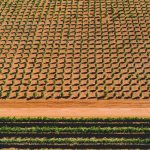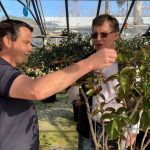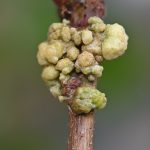With some uncertainty hanging over the ongoing use of chemicals to control weeds, regular writer Sam Bowman explores some of the alternatives.
The world seems to be turning in its approach and taste for organic produce and a sustainable, health conscious way of life. Worldwide, the market for organics was valued at USD $81.6 billion in 2015, a fourfold increase from 2000. Australians are the 16th largest consumer of organic produce globally averaging a $26 per capita spend on organics annually. It just makes sense that these lifestyle choices flow onto consumers’ alcohol choices and, in particular, wine.
Many wine companies across Australia employ organic principles and a select number have sought certified organic status not only for their vineyard practices but also their winemaking facilities. In New South Wales only 17 wine companies are organically certified out of the many regions (150 wine producers in the Hunter Valley alone) proving that it is no mean feat to produce under certified regulations.
For viticulture in particular, the limiting factor for success in an organic system seems to be nutrition management in low fertility soils and weed management regardless of region. With many recent high-profile court rulings against Monsanto (which is now owned by Bayer) linking the active constituent of Roundup (glyphosate) to causing nonHodgkin’s lymphoma, and mounting weed resistance each season, there is a great uncertainty to the future use of herbicides in vineyard systems. If you are considering reducing dependence on sprays it is a good idea to weigh up the alternative options available before taking the plunge into certification.
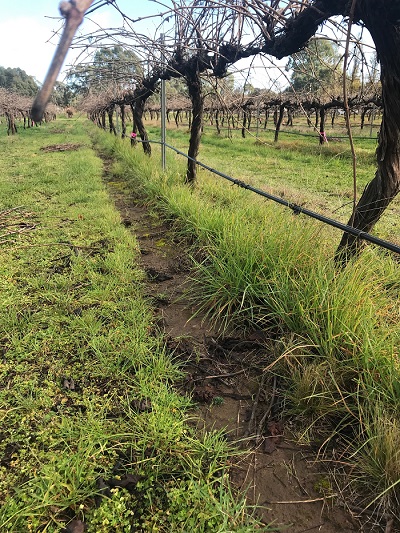
Trials
During the 2018-19 growing season NSW Department of Primary Industries viticulture officer Darren Fahey facilitated three regional trials investigating the efficacy of weed control alternatives. The project (funded by Wine Australia) hopes to determine the best practice for weed management in an organic system. Sites in Orange, Mudgee and Hilltops were utilised with flame, steam, contact sprays and mulch applications applied and measured for their weed control efficacy.
Speaking with Fahey about the results he suggests that each site will require a different management response based on the weed species and the timing of the germination. Often the best approach is to change nothing at all, as was the case for an organic vineyard studied in Mudgee which had the best result with its current practice of running sheep in the vineyard from harvest to budburst and midrow slashing compared to using dessicants, steam, flame and mulch.
The least expensive option came in the form of acetic acid which provided similar weed control to the other contact dessicants at $163/ha with mulch the most expensive at $5049/ha, keeping in mind the mulch is a one-in-three-year application and provides other benefits to soil health and water efficiency along with weed suppression. In terms of a clear standout it seems there is more work to be done across differing seasonal conditions. “Environmental conditions play a major part of the choice of which weed control option to go with,” said Fahey. “Drier climates tend to have less undervine weed pressure, so targetted spot spraying using weed detection technologies means desiccant sprays applied at early growth stages will be a cost-effective solution. Higher rainfall areas may be better off planting specific native grasses as cover crops undervine (Penfold and Howie 2019) so in the longer term less maintenance is required. More work needs to be done before a single option could be advised as the best option.”
Watch this space for Year 2 of the trial work in New South Wales.
Case Study
Jan O’Connor and Richard Oliver own and manage O’Connor Harvesting which operates from the Hunter Valley to Mildura and across South Australia. Along with harvesting 4000 hectares of vineyard annually, they also own the certified organic ‘Trillians Run’ vineyard in the Clare Valley. Richard shared his thoughts on their challenges and successes with organic
weed management.
Tell us about your vineyard and organic certification
Our vineyard, known as ‘Trillians Run’, is located 3km south-east of Sevenhill, in the Clare Valley, South Australia on the headwaters of the Hutt River. A significant ridgeline runs north-south, dissecting our property. This ridgeline is effectively the watershed of the Hutt River Valley and The Polish Hill River Valley. We have an elevated site ranging from 500 to 540 metres elevation, with Trillians Hill at the highest point.
We have a total of 12.2 hectares planted, comprising 6.1ha of Shiraz and 6.1ha of Riesling, planted in 2004. Our organic certification process started in 2010 and we became 100% certified organic in 2013.
What weed control methods have you used in the past and why did you decide to adopt other methods (if any)?
• slashing in the mid row — still use
• undervine slashing — damage to vines and irrigation system due to operator error (fall back option)
• undervine cultivation with a Clemens plough; timing: we did this for three seasons — in the first season the exposing and aerating of dormant weed seeds created a few headaches, however the interesting result was a complete change of weed species from broadleaf to grasses; not a great fan of continuous soil disturbance (fall back option)
• organic sheep for winter grazing – still use
• larger, woodier weeds such as Phyllaris and Blackberry have been manually removed and are now of minimal concern
• new sheep onto the property have to be detoxed for three weeks in a separate paddock before entering the vineyard for weed control duty
• experimented with pine oil — very expensive because of concentrated application rates.
Steam weedicide unit
Last growing season we purchased a Weedtechnics Steam Weedicide Unit. We have completed many trials and are confident that it will work if applied at the appropriate time of the weed growth cycle. Currently we have sheep in the vineyard, keeping them there over winter until just before budburst. Once the sheep are removed just prior to budburst we will start the steam weedicide process before undervine growth gets away from us due to no sheep and warmer soils.
Positives
• can operate weedicide unit in many conditions that you can’t do with chemical herbicides e.g., wind, heat, even light rain
• after several effective passes, undervine weeds should be relatively easy to control
• as with most things, the hard yards, i.e. time, has to be spent to lay a foundation for making life easier in the future • no dangers of chemical handling/ overspray/ drift etc.
Negatives
• slow and time consuming (1-2km/h)
• uses about 1000 litres every 1 to 1.5 hours, so travel and fill up times add significantly to the overall
time consumption
• due care in using the unit with superheated steam.
What is your greatest challenge in an organic system?
• Undervine weed control, particularly in drought years; weeds will take substantial moisture, competing
with vines.
• Sourcing appropriate fertilisers and nutrition, materials and the cost thereof and the cost of freight.
• Clare Valley water prices (everywhere actually).
• Time, or lack of it; I would dearly love to return to a cycle of compost teas to improve the soils in the vineyard, which are variable in quality and condition to get them back to freshsmelling, friable soils.
• For several years we did everything with composting and compost teas achieving very good results, even in severe disease years. Unfortunately, grape prices did not allow us to continue this practice as we could not justify a full-time person dedicated to the vineyard to make compost and compost teas; it has to be made correctly, which takes time and effort but a worthwhile endeavour.
• Water quality for the steam weedicide unit.
• Overall management — as an organic grower there are limited instant fixes readily available off the shelf, as with normal practices, particularly in seasons with high disease pressures. We are fortunate that we have a passionate, experienced vineyard manager in Melissa Eaton. She overcomes most of nature’s obstacles and allows the vineyard to be productive in very trying conditions, like last year.

Undervine cover crops and cultivation options
Travelling through the vineyard regions of France and Italy, you will notice that cultivated undervine area is quite common for weed control and to increase rainfall penetration to the root zone. Many producers in regions where irrigation is outlawed use midrow and under-vine cultivation to drive the feeder roots to depth to avoid stress during heat events. In Australia, we seem to be transfixed on the picturesque view down a row of a green mid-row and a bare under-vine area (which in some regions with high cropping levels is a necessity to reduce competition). But there can be many benefits to undervine grass growth, as explored by Dr Chris Penfold, research officer with the School of Agriculture, Food and Wine at The University of Adelaide. Penfold has had great success in moderate yielding vines (6-10t/ha) with undervine cover crops for both weed suppression and increases in soil health. His trials in the Barossa Valley, Eden Valley, Langhorne Creek and Waikerie are worth a look for anyone in an area with moderate rainfall looking at reducing the use of herbicides.
The FMR group, based in South Australia, has a range of undervine cultivation equipment which is rising in popularity according to business manager Cam Clifford. A recent trial in the Murray Darling on a 12-month-old vineyard was impressive using the Xtrem multi tool carrier fitted with a Bähr roller hoe and finger weeder. The operator managed to travel at 10km/hr and the unit requires each row to be completed, but it looks to be a good option for instances where cultivation is needed in combination with other knockdown methods.
I currently have two large clients in warm regions in the process of organic conversion so am seeing this shift first hand. Whether the shift is driven by market demand or an ideological shift in thinking, I think we can all agree that reducing synthetic inputs in farming is a step in the right direction.
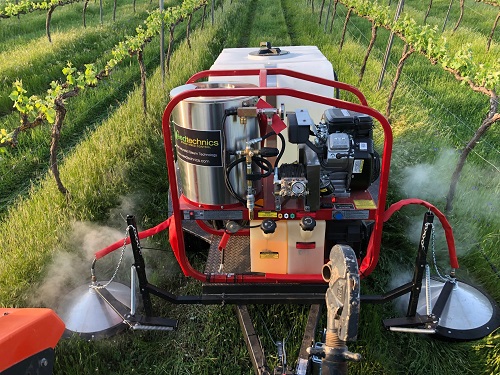
References and further reading
Penfold, C. and Howie, J. (2019) Under-vine cover cropping. Wine Australia fact sheet.
www.wineaustralia.com/ getmedia/384c2ac3-b0b1-4c7b-9c7ca8904090a69b/CORD_Factsheets_ CoverCropsUndervine_V2, accessed 13 August 2019.
Penfold, C.; Weckert, M.; Nordblom, T. and Howie, J. (2018) Development of a low-input under-vine floor management system which improves profitability without compromising yield or quality. Final report to Wine Australia. www.wineaustralia.com/ research/search/completed-projects/ua-1303, accessed 13 August 2019.
This article was originally published in the September 2019 issue of Grapegrower & Winemaker magazine. Subscribe here.

